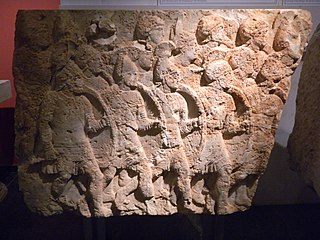Agesilaus II was king of Sparta from c. 399 to 358 BC. Generally considered the most important king in the history of Sparta, Agesilaus was the main actor during the period of Spartan hegemony that followed the Peloponnesian War. Although brave in combat, Agesilaus lacked the diplomatic skills to preserve Sparta's position, especially against the rising power of Thebes, which reduced Sparta to a secondary power after its victory at Leuctra in 371 BC.

Amyntas III was king of the Ancient Greek kingdom of Macedonia in 393 BC and again from 392 to 370 BC. He was the son of Arrhidaeus and grandson of Amyntas, one of the sons of Alexander I. His most famous son is Philip II, father of Alexander the Great.
This article concerns the period 379 BC – 370 BC.
This article concerns the period 389 BC – 380 BC.
This article concerns the period 369 BC – 360 BC
Year 399 BC was a year of the pre-Julian Roman calendar. At the time, it was known as the Year of the Tribunate of Augurinus, Longus, Priscus, Cicurinus, Rufus and Philo. The denomination 399 BC for this year has been used since the early medieval period, when the Anno Domini calendar era became the prevalent method in Europe for naming years.
Year 327 BC was a year of the pre-Julian Roman calendar. At the time, it was known as the Year of the Consulship of Lentulus and Philo. The denomination 327 BC for this year has been used since the early medieval period, when the Anno Domini calendar era became the prevalent method in Europe for naming years.
Year 281 BC was a year of the pre-Julian Roman calendar. At the time it was known as the Year of the Consulship of Barbula and Philippus. The denomination 281 BC for this year has been used since the early medieval period, when the Anno Domini calendar era became the prevalent method in Europe for naming years.
Year 380 BC was a year of the pre-Julian Roman calendar. At the time, it was known as the Year of the Tribunate of Poplicola, Poplicola, Maluginensis, Lanatus, Peticus, Mamercinus, Fidenas, Crassus and Mugillanus. The denomination 380 BC for this year has been used since the early medieval period, when the Anno Domini calendar era became the prevalent method in Europe for naming years.

Lysimachus was a Thessalian officer and successor of Alexander the Great, who in 306 BC, became King of Thrace, Asia Minor and Macedon.

Nectanebo II was the last native ruler of Ancient Egypt, as well as the third and last pharaoh from the Thirtieth Dynasty of Egypt. He reigned from 358 to 340 BC.

The Thirtieth Dynasty of Egypt is usually classified as the fifth Dynasty of the Late Period of ancient Egypt. It was founded after the overthrow of Nepherites II in 380 BC by Nectanebo I, and was disestablished upon the invasion of Egypt by the Achaemenid king Artaxerxes III in 343 BC. This is the final native dynasty of ancient Egypt; after the deposition of Nectanebo II, Egypt fell under foreign domination.
Leotychidas II was king of Sparta between 491–476 BC, alongside Cleomenes I and later Leonidas I and Pleistarchus. He led Spartan forces during the Persian Wars from 490 BC to 478 BC.
Cleomenes II was king of Sparta from 370 to 309 BC. He was the second son of Cleombrotus I, and grandfather of Areus I, who succeeded him. Although he reigned for more than 60 years, his life is completely unknown, apart from a victory at the Pythian Games in 336 BC. Several theories have been suggested by modern historians to explain such inactivity, but none has gained consensus.

Djedhor, better known as Teos or Tachos, was an ancient Egyptian pharaoh of the 30th Dynasty.
Eudamidas I was Spartan king between 331 and c. 300 BC. He succeeded his brother Agis III, who died at the battle of Megalopolis against Macedonia. Eudamidas' reign was therefore peaceful as Sparta recovered from this disaster. He even refused to join the other Greek states in the Lamian War in 323, and was later noted for his interest in philosophy—peculiar for a Spartan king.

The Great Satraps' Revolt, or the Revolt of the Satraps, was a rebellion in the Achaemenid Empire of several satraps against the authority of the Great King Artaxerxes II Mnemon. The Satraps who revolted were Datames, Ariobarzanes and Orontes of Armenia. Mausolus the Dynast of Caria participated in the Revolt of the Satraps, both on his nominal sovereign Artaxerxes Mnemon's side and (briefly) against him.
An Illyrian invasion of Molossians in Epirus occurred in 385 BC. Illyrians, led most likely by king Bardylis, were supported by Dionysius I of Syracuse who was aming to expand his influence in the eastern Adriatic Sea and Ionian Sea, and by Alcetas I of Epirus who was expelled from his land by the Molossian pro-Spartan party and exiled in Syracuse.





